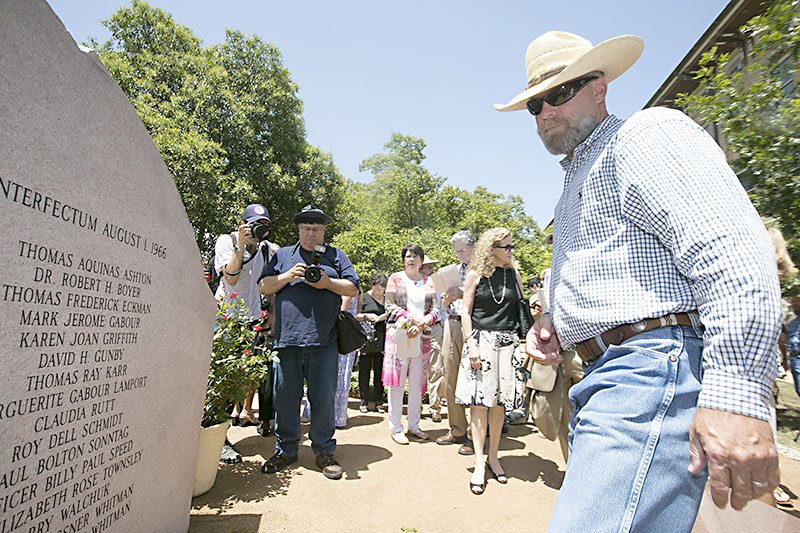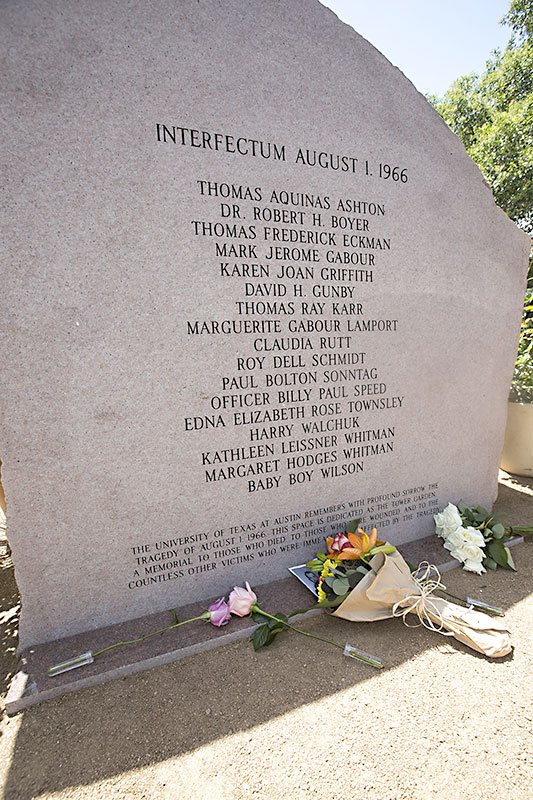For Whom the Bells Toll
Lege enacts campus carry on the 50th anniversary of the UT Tower shooting
By Annamarya Scaccia, Fri., Aug. 5, 2016

The University of Texas at Austin tower carillon tolled at 11:40am.
Hundreds of people, assembled at the university's Main Mall on Monday, grew still. All that could be heard was the crunch of pebbles beneath shoes. The shutter of cameras. The whips of paper fans.
The minutes moved slowly as the crowd waited underneath the blistering sun for the tower clock to strike 11:48. At that time, 50 years ago on Aug. 1, Charles Whitman took his first shot while perched on the tower's observation deck. He hit Claire Wilson James, then 18 years old and eight months pregnant, in the stomach, killing her unborn child. His second shot killed her boyfriend, Thomas Eckman. The 25-year-old former Marine sharpshooter would go on to kill 14 people, hours after murdering his mother Margaret and wife Kathleen. He wounded 32 others. Hundreds, if not thousands, would feel the impact of what is considered the first modern mass shooting of its kind.
11:48am came. The tower clock stopped. For the second time in its history, it will have stopped for 24 hours – this time to honor of 50th anniversary of the UT Tower shooting.
As people gathered on Monday, another event loomed: the implementation of the so-called campus carry law, the controversial bill that permits students to carry concealed handguns on campus and in classrooms. In what many have called a twisted sense of irony, the Texas Legislature chose to put the law into effect on the semicentennial of the worst day in the university's history.
"It's in bad taste," Rick Cloud, a UT alum of 1969, said before the ceremony.
Cloud was in an engineering class when the shooting began. Whitman was supposed to be sitting in the empty seat in front of him, but Cloud wouldn't realize that until after the shooting, when he entered his off-campus apartment and saw Whitman's face on TV. Whitman was different from the other engineering students, Cloud said – older, married, an ex-Marine. He described Whitman as a sharp dresser who would bite his nails to "the bit." Cloud will always remember Whitman's nails.
Cloud understands gun violence can happen anywhere, at any time, but the dates overlapping made the ceremony more heartbreaking. "I'm not sure what [lawmakers] were trying to prove with that," he said.
It's unclear why the Legislature chose Aug. 1 to enact campus carry for state four-year colleges and universities. Lt. Gov. Dan Patrick claimed he was unaware of the convergence of dates until asked at the Texas Tribune Festival last year. Maria Hammack, a Ph.D. student in UT's history program, said Patrick's ignorance might be a symptom of forgetting history. "When people go through tragedies like that, people try to forget the past," said Hammack.
Hammack was one of nearly a dozen UT graduate students who spent seven months on "Behind the Tower," a multipart account of the shooting culled from university archives, public records, and oral histories. Hammack, who found out that the first mass school shooting actually happened in Mississippi in 1891, theorized that lawmakers might not have had the anniversary on their minds when picking the date. "[But] it's important for politicians to understand the history of the state they're writing laws for," she said.
Lobbyist Jason Sabo said it's more likely the Legislature wanted to get the bill enacted before the academic year began. (The law goes into effect Aug. 1, 2017, for state junior and two-year colleges.) The coincidence is "just icing on the cake" for a Legislature that's used a decades-old event to justify campus carry today, said Sabo, who owns Frontera Strategy, a for-profit public interest lobby firm that represents Everytown for Gun Safety.
Sabo said the shooting was dissected at every public hearing on campus carry. Many claimed that armed civilians made it harder for Whitman to shoot people. Others argued that the citizens who returned fire made it harder for police to do their job. But of the hundreds of mass shootings that happened over the decades, few examples exist of "good guys with guns" stopping carnage.
"I can't quarrel with the fact that the civilian fire played a role. But it's such an anomaly," said Monte Akers, co-author of Tower Sniper: The Terror of America's First Active Shooter on Campus, a historical nonfiction book on the shooting released last week.
For Dr. Roger Friedman, Monday represented 50 years without his closest childhood friend, Paul Bolton Sonntag, whom Whitman shot and killed along with Sonntag's fiancée, Claudia Rutt. Friedman had known Sonntag since he was 8 years old. They went to elementary and junior high school together in Austin. He was fresh out of high school when Sonntag was killed, and his friend's death has weighed heavy on him ever since. During Tuesday's book launch, as Friedman read an excerpt from Tower Sniper – a passage he wrote about his childhood friend – Sonntag's image, mounted on the wall, watched over him.
"Every survivor, witness, policeman, first responder, and all of their families are traumatized by the event," Dr. Friedman told the Chronicle days before the ceremony. Friedman, a psychologist and social worker who focuses on trauma, said the campus carry law made him nervous to attend Monday's event. "If the Legislature now understood how widespread the cloud of trauma is, they damn sure wouldn't have implemented this thing on Aug. 1."
The Legislature isn't the only entity that's taken heat on the subject. In the past 50 years, the university has done little to acknowledge the shooting, survivors say. During Monday's ceremony, UT-Austin President Gregory Fenves admitted that the commemoration was "long, long overdue." No mention of the tragedy exists on the Tower's history page. The institution dedicated the Tower Garden to the victims in 1999, with a small plaque installed in 2007, but students who spoke to the Chronicle said many on campus have no idea about the garden's significance. Until now, UT seems to have adopted a code of silence, they say. "So much of it has fallen on the context of what happened. We just didn't have that context to compare to," said Erica Sáenz, associate vice president of UT's Division of Diversity & Community Engagement.
Two years ago, Claire Wilson James, Jim Bryce, and other survivors convened the Texas Tower Memorial Committee to push UT to properly memorialize a tragedy that defined a generation. What resulted was a granite cenotaph inscribed with the names of Whitman's victims, one of whom died in 2001 as a result of injuries sustained on that day. Unveiled on Monday, the pink stone memorial is made from the same material as the Texas State Capitol.
Sáenz said UT didn't have a precedent on how to handle a mass shooting, unlike today. Instead, Whitman's rampage happened during a time when you didn't talk about tragedy, she said. But "here we are, 50 years later. We want to bring light to it in a significant way," she said.
At the end of Monday's ceremony, the victims' names were read out loud. Stillness befell the crowd.
"Thomas Aquinas Ashton," started Clif Drummond, president of UT's student government in 1966. The tower carillon tolled. "Dr. Robert H. Boyer," read Kevin Helgren, the university's current student president. Another chime.
Drummond and Helgren went down the list of 17 names – each with a pause, each with a sounded knell. Then came the name of Claire Wilson James' unborn child.
"Baby Boy Wilson," Drummond said, his voice breaking.
After a moment of silence, Helgren followed. "We toll the bell once more for all those who suffered from the tragedy on Aug. 1, 1966."
The final bell rang.
View the accompanying photo gallery of the event at austinchronicle.com/photos.
Got something to say on the subject? Send a letter to the editor.











